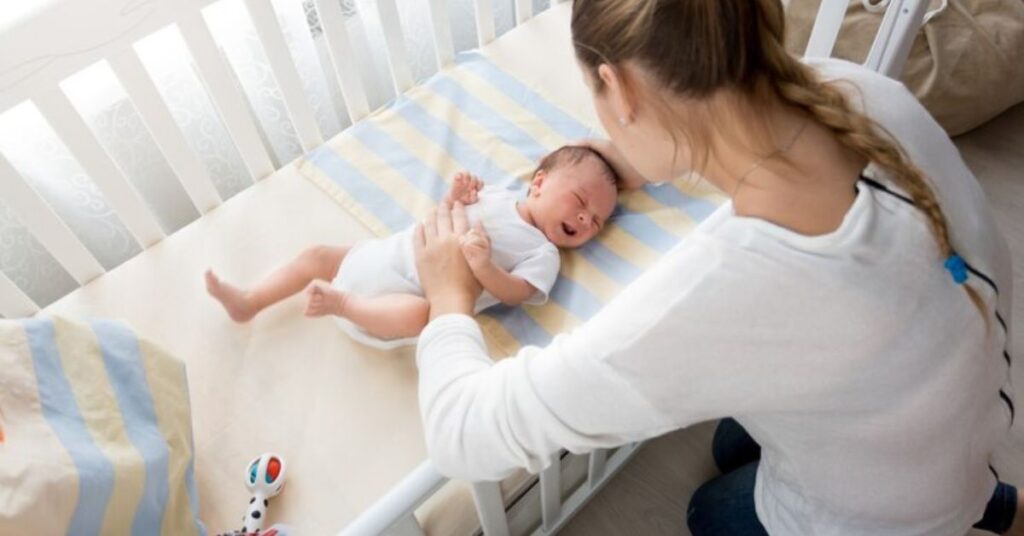Last Updated on October 29, 2023 by Muhammad Sohaib
Transferring a sleeping baby to their crib can be a delicate and challenging task for many parents.
As babies often fall asleep in their parent’s arms or in a different sleep environment, the transition to the crib requires care and patience to avoid waking them up.
In this blog, we will explore safe and gentle techniques to successfully transfer a sleeping baby to their crib while ensuring their comfort and uninterrupted rest.
Understanding the Importance of Safe Sleep
Before we delve into the transfer process, it’s crucial to understand why it’s essential to have your baby sleep in their crib.
The American Academy of Pediatrics (AAP) recommends that babies sleep in their cribs on a firm mattress with no loose bedding or soft toys to minimize the risk of Sudden Infant Death Syndrome (SIDS).
By transitioning your baby to their crib, you’re creating a safe sleeping environment that follows these guidelines, ensuring their well-being.
Preparing the Crib
Create a Comfortable Sleep Environment

Ensure your baby’s crib is set up for maximum comfort. Use a firm mattress, fitted sheet, and sleepwear appropriate for the room’s temperature. The room should be at a comfortable and safe temperature, typically around 50-71°F (16-22°C).
Remove Hazards:
Clear the crib of any loose blankets, stuffed animals, or pillows. These items can pose suffocation risks, and it’s best to follow the “bare is best” rule in the crib.
Transfer the Art of Sleeping Baby
Now, let’s explore the steps to transfer your sleeping baby to their crib without causing a stir.
1. Timing is Key
The first rule of transferring a sleeping baby is to choose the right moment. Wait until your baby is in a deep sleep. You can usually tell by observing their breathing pattern and muscle relaxation.
2. Warm the Crib
Babies often wake when transferred to a cold surface. Warm the crib with a heating pad before laying your baby down, and then remove it before placing your baby inside.
3. Position the Crib Nearby
Place the crib near your bed for the first few months to make nighttime feedings and check-ins more manageable.
4. Lay Them Down Gently
Slowly and gently lower your baby into the crib. Start by placing one hand under their head and the other under their bottom. Keep them as horizontal as possible. Make sure their feet touch the crib’s bottom so they feel secure.
5. Maintain Skin Contact
To make the transition feel seamless, maintain gentle skin-to-skin contact with your baby. This helps them feel secure and reduces the sudden change in temperature.
6. Use White Noise
A white noise machine or a fan can help drown out the noise of the transfer and create a soothing atmosphere for your baby.
7. Keep Eye Contact
As you lay your baby down, maintain eye contact and offer a soothing smile. Let them know you’re there, and this change is part of the routine.
Also Read: Best Baby Monitors
8. Soothing Your Stirring Baby
Sometimes, your baby may stir or start to wake up during the transfer. In such cases, gently pat their back or offer a pacifier to help them fall back asleep.
9. The Slow-Motion Approach
Taking things slow can be the key to a successful transfer. We’ll outline the steps for a gradual transition.
10. The Pat-Pat Method
Gently patting your baby to sleep is a time-tested technique. We’ll provide instructions on how to do it correctly.
Troubleshooting Common Issues
Transferring a sleeping baby to their crib doesn’t always go smoothly. Here’s how to deal with common Issues:
Baby Wakes Up: If your baby wakes up during the transfer, don’t panic. Maintain a soothing presence and try to calm them with a gentle touch or a pacifier. Avoid making sudden movements or loud noises.
Fussiness: Babies can become fussy during the transition. Patience is key. Offer comfort and reassurance through gentle rocking or soft singing.
Try a Swaddle: Swaddling can help keep your baby snug and secure, which can ease the transition. Just be sure to follow safe swaddling guidelines.
Practice Safe Sleep Training: If you’re transitioning your baby to their crib after a period of co-sleeping or in a bassinet, consider starting with daytime naps. This gradual approach can help your baby get used to the crib.
Consistency is Key
Remember, consistency is crucial when it comes to transitioning your baby to their crib. Following a consistent bedtime routine can make the process easier.
Here’s a sample bedtime routine that you can adapt to your baby’s needs:
Bath Time: Start with a soothing warm bath to relax your baby.
Massage: Gently massage your baby with baby-safe lotion or oil.
Story Time: Read a short, calming story to your baby.
Feeding: Offer a final feeding session before putting your baby down.
White Noise: Turn on the white noise machine or fan to create a calming atmosphere.
Lullaby: Sing a soft lullaby to your baby.
Transition to Crib: Finally, transfer your baby to their crib while following the steps mentioned earlier.
Tips for Success
To ensure a smooth transition, here are some additional tips to keep in mind:
Stay Calm: Your baby can sense your stress. Try to stay calm and composed during the transfer.
No Rush: Don’t rush the process. Take your time to ensure your baby is in a deep sleep before transferring them.
Safe Sleep Guidelines: Always adhere to the safe sleep guidelines recommended by the AAP to reduce the risk of SIDS.
Consistency: Consistency is key. Stick to your routine, and over time, your baby will adjust to their crib.
Conclusion
Transitioning a sleeping baby to their crib may seem like a daunting task, but with the right approach, it can be a smooth and stress-free process.
By creating a comfortable sleeping environment, mastering the art of the transfer, and maintaining a consistent bedtime routine, you can help your baby sleep peacefully in their crib. Remember, patience and gentle care are your best allies in this journey.
In the end, it’s all about creating a safe and comforting space for your little one to rest and grow. Sweet dreams to you and your baby!






